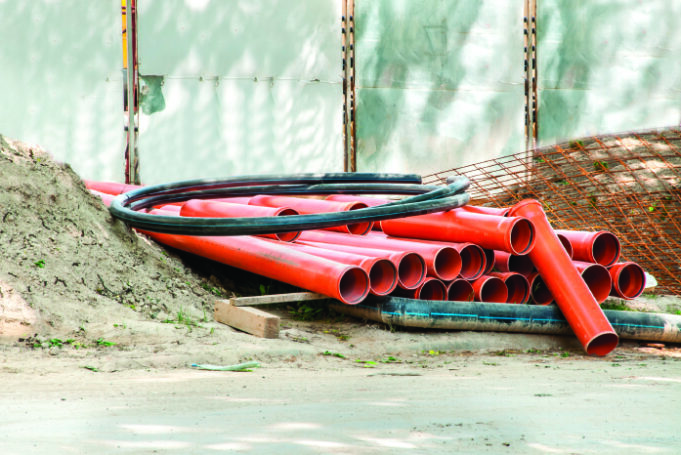By Mark Ligon
Over the last 50 years, the plumbing industry has seen a huge shift in piping materials. Contractors and plumbers have swapped costly steel and metal piping in favor of less expensive plastic piping in most new construction projects, without sacrificing durability. Read on to learn more about the benefits and limitations of a variety of piping materials, and which are best suited for certain applications.
PLASTIC PIPING
PVC Pipes: Polyvinyl chloride piping, also known has PVC, is a popular piping option for new construction projects, and for good reason. PVC piping is lightweight and less expensive than other piping materials. It can be installed in both warm and cold climates, as well. Durable PVC comes in two sizes: Schedule 40, which is more commonly used, and Schedule 80, which has thicker walls, increasing durability and costs. Both sizes are easy to install, requiring only solvent cement at the joints.
While PVC is strong, it has a shorter lifespan than other piping materials. It also has heat limitations and cannot be used in applications where water temperatures top 140 °F. PVC shouldn’t be used to transport drinking water but can be installed where higher water pressure is needed. Use PVC piping in drain lines, main water lines, vent stacks, and storm drainage.
CPVC Pipes: Chlorinated polyvinyl chloride, or CPVC, piping is similar to PVC piping but with added chlorine. Plumbers and contractors will still enjoy many of the benefits of PVC piping, like its lightweight design and easy installation, but with added durability and heat resistance. Unlike PVC, which cannot be used with water temperatures exceeding 140 °F, CPVC can withstand temperatures up to 200 °F. It’s also fire resistant and more flexible than standard polyvinyl chloride.
These added features do come at a slightly higher price than PVC, but the versatility of CPVC may be worth the extra cost. Consider using CPVC piping in hot drain lines, wastewater disposal, and even transporting drinking water.
PEX Pipes: PEX piping, also known as polyethylene cross-linked pipe, is another plastic piping material that has gained popularity in recent years. One benefit of PEX is its flexibility. It can easily snake through walls or in crawl spaces, and because it uses compression fittings, solvent cement is not necessary when joining and installing. PEX comes in a wide variety of sizes, which makes it a great option for retrofitting in older homes, as well.
The initial cost of PEX piping is higher than other plastic piping, but installation and maintenance costs are typically much lower. While it is heat resistant, PEX cannot be attached directly to a hot water heater and must instead be connected to an 18-inch section of another heat resistant piping, like copper. PEX is often used for water supply lines and in areas of construction where bending and snaking are necessary.
COPPER PIPING
Copper piping became a popular building supply in the 1960s, and because of its durability and long lifespan, many older homes still have original copper in them. One reason for the longevity of copper piping is that it is resistant to heat and corrosion. It’s also antimicrobial, which means it’s a good choice for drinking water supply lines, HVAC refrigerant lines, and underground services lines.
Additional fittings and soldering are required when joining copper piping, which makes the process to install more tedious. However, it also creates a tight seal, which cuts down on the potential for leaking. Used copper can also be recycled. Copper piping is more expensive than other piping options. Unfortunately, the high price of copper often makes it a target of theft at unattended jobsites.
BRASS PIPES
Another higher priced option, brass piping may be the right choice for a limited number of applications. It’s long lasting and resistant to corrosion and heat damage. Because brass is softer than copper, a tighter seal can be achieved, as well. In the past, there were concerns that brass pipes may contain lead. However, plumbers and contractors can now purchase lead-free brass that is safe for supplying drinking water, as well as drain lines and gas lines.
STAINLESS STEEL (SS) PIPES
When it comes to appliances, stainless steel is a trend that doesn’t seem to be ending anytime soon. Stainless steel piping, on the other hand, may look great, but it’s not always the right choice. Like other piping materials, stainless steel is durable, and it also comes in both rigid and flexible options and a variety of sizes. Installation and retrofitting, however, can be more challenging with stainless steel because specific couplings are required. It also comes at a much higher price point than other materials. One important feature of stainless steel is that it is highly resistant to corrosion. Because of this, it is often used in areas where corrosion could occur, like coastal regions.
CLOSING THOUGHT
Unlike several years ago, when plumbers and builders had a limited number of piping options, today there are many, each with its own benefits and challenges. Consider the location and function of the piping needed, as well as the overall budget of the project when selecting the piping material that is best suited for your new construction building.
About the author:
Mark Ligon is the marketing manager at Commercial Industrial Supply, a distributor of industrial piping, valves, and fittings. Since 2009, CIS has been dedicated to providing the best name brand products to customers in a wide range of industrial, commercial, and residential settings. For more, reach out to Mark at www.commercial-industrial-supply.com.
Modern Contractor Solutions, July 2021
Did you enjoy this article?
Subscribe to the FREE Digital Edition of Modern Contractor Solutions magazine.



